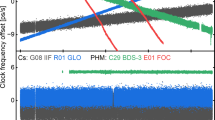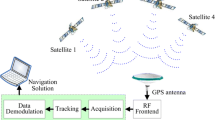Abstract
Clock steering is crucial for Global Navigation Satellite System (GNSS) timing receivers to provide high-performance time and frequency. However, the lack of theoretical analysis and design methods makes it difficult to apply an existing controller to the emerging real-time precise point positioning (RT-PPP) timing receiver. In this research, a Linear Quadratic Gaussian (LQG)-based clock steering method for the RT-PPP timing receiver is proposed with a detailed design process. We theoretically derive the transfer function of the system first. Then, the relationship between the system bandwidth and the control parameter is present. As for the parametric design, based on the analysis of the free-running oscillator instability, the RT satellite clock reference variation, and the GNSS observation noise, the parameters of the Kalman estimator are set, and the optimal bandwidth of the system is estimated. Under the constraint of the bandwidth and the damping ratio, the control parameters of the LQG controller are determined finally. Simulated results show that the parametric design method is feasible for different noise conditions. And finally, we evaluate the performance of the proposed clock steering method on a Rubidium clock RT-PPP timing receiver. Experimental results show that the timing receiver realizes the optimal combination of the short-term stability of the Rubidium clock and the long-term stability of the RT-PPP reference expectedly. The precision of the output one pulse per second (1PPS) is 0.21 ns over 24 h. And the frequency stabilities can reach 3.59E-12@1s and 2.43E-14@10000s, which is more stable than a high-quality Cesium clock.













Similar content being viewed by others
Data availability
The datasets generated during and/or analyzed during the current study are available from the corresponding author on reasonable request.
References
Allan DW (1987) Time and frequency (time-domain) characterization, estimation, and prediction of precision clocks and oscillators. IEEE Trans Ultrason Ferroelectr Freq Control 34(6):647–654. https://doi.org/10.1109/t-uffc.1987.26997
Franklin GF, Powell JD, Emami-Naeini A, Powell JD (2002) Feedback control of dynamic systems, vol 4. Prentice hall, Upper Saddle River
Franklin GF, Powell JD, Workman ML (1998) Digital control of dynamic systems, vol 3. Addison-Wesley, Reading
Gardner FM (2005) Phaselock techniques. Wiley, Sons
Guo W, Zuo H, Mao F, Chen J, Gong X, Gu S, Liu J (2022) On the satellite clock datum stability of RT-PPP product and its application in one-way timing and time synchronization. J Geodesy 96(8):52. https://doi.org/10.1007/s00190-022-01638-5
Guo W, Song W, Niu X, Lou Y, Gu S, Zhang S, Shi C (2019) Foundation and performance evaluation of real-time GNSS high-precision one-way timing system. GPS Solut 23:1–11. https://doi.org/10.1007/s10291-018-0811-1
Hajimiri A (2001) Noise in phase-locked loops. In: 2001 Southwest Symposium on Mixed-Signal Design (Cat. No. 01EX475) (pp. 1–6). IEEE. https://doi.org/10.1109/SSMSD.2001.914927
Koppang P, Leland R (1999) Linear quadratic stochastic control of atomic hydrogen masers. IEEE Trans Ultrason Ferroelectr Freq Control 46(3):517–522. https://doi.org/10.1109/58.764838
Koppang, P., Johns, D., Skinner, J. (2003). Application of Control Theory in the Formation of a Timescale. Proceedings of ION PTTI 2003, Institute of Navigation, San Diego, California, USA, December 2–4, (pp. 319–326)
Kroupa V (1982) Noise properties of PLL systems. IEEE Trans Commun 30(10):2244–2252. https://doi.org/10.1109/TCOM.1982.1095404
Kusters JA (1996) The global positioning system and HP smartclock. Hewlett Packard Journal 47(6):60–67
Matsakis D (2019) The effects of proportional steering strategies on the behavior of controlled clocks. Metrologia 56(2):025007. https://doi.org/10.1088/1681-7575/ab0614
Mishagin KG, Lysenko VA, Medvedev SYE (2019) A practical approach to optimal control problem for atomic clocks. IEEE Trans Ultrason Ferroelectr Freq Control 67(5):1080–1087. https://doi.org/10.1109/TUFFC.2019.2957650
Ramachandran D, Din AHM, Ibrahim SA, Omar AH (2019) Real-time precise point positioning (RT-PPP) for positioning and mapping. In: GCEC 2017: Proceedings of the 1st Global Civil Engineering Conference 1 (pp. 891–913). Springer Singapore. https://doi.org/10.1007/978-981-10-8016-6_64
Riley WJ, Howe DA (2008) Handbook of frequency stability analysis. NIST Sp
Rønningen OP, Danielson M (2019) A novel PPP disciplined oscillator. In: 2019 Joint Conference of the IEEE International Frequency Control Symposium and European Frequency and Time Forum (EFTF/IFC) (pp. 1–4). IEEE. https://doi.org/10.1109/FCS.2019.8856034
Wu Y, Gong H, Zhu X, Ou G (2016) A DPLL method applied to clock steering. IEEE Trans Instrum Meas 65(6):1331–1342. https://doi.org/10.1109/TIM.2016.2526699
Acknowledgements
This work was supported by the National Key Research and Development Program of China under Grant 2021YFB3900703 and the National Natural Science Foundation of China under Grant 42227802, 41974038, 42174029, and 41931075.
Funding
This work was supported by the National Key Research and Development Program of China under Grant 2021YFB3900703 and the National Natural Science Foundation of China under Grant 42227802, 41974038, 42174029, and 41931075.
Author information
Authors and Affiliations
Contributions
Author WG and SG designed the research; WG, MZ, HZ, and SG performed the research; WG, MZ, and SG analyzed the result; WG, MZ, and SG drafted the paper. All authors discussed, commented on, and reviewed the manuscript.
Corresponding author
Ethics declarations
Conflict of interest
The authors have no competing interests to declare that are relevant to the content of this article.
Consent for publication
The work described has not been published before; that it is not under consideration for publication anywhere else; that its publication has been approved by all co-authors, if any, as well as by the responsible authorities—tacitly or explicitly—at the institute where the work has been carried out.
Additional information
Publisher's Note
Springer Nature remains neutral with regard to jurisdictional claims in published maps and institutional affiliations.
Rights and permissions
Springer Nature or its licensor (e.g. a society or other partner) holds exclusive rights to this article under a publishing agreement with the author(s) or other rightsholder(s); author self-archiving of the accepted manuscript version of this article is solely governed by the terms of such publishing agreement and applicable law.
About this article
Cite this article
Guo, W., Zhu, M., Gu, S. et al. Linear quadratic Gaussian-based clock steering system for GNSS real-time precise point positioning timing receiver. GPS Solut 28, 53 (2024). https://doi.org/10.1007/s10291-023-01592-5
Received:
Accepted:
Published:
DOI: https://doi.org/10.1007/s10291-023-01592-5




